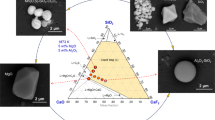Abstract
Volatilization loss of molybdenum trioxide (MoO3) always takes place during the synthesis of Mo-containing alloying steel in the steelmaking process. In this work, the sublimation kinetics and mechanism of MoO3 in the range of 1273 to 1373 K were analyzed, in which the methods of model fitting, FE-SEM, EDS, and thermodynamic calculation were adopted. The results showed that sublimation of high-purity MoO3 (defined as the case III) and industrial grade MoO3 with the thickness of 3 mm (defined as the case II) were mainly controlled by the chemical reaction on the surface; increasing the thickness of industrial grade MoO3 to 7 mm (defined as the case I), the diffusion model was obeyed, instead. Activation energies of the three cases were extracted to be 127.489 (case III), 197.418 (case II), and 89.76 kJ/mol (case I), respectively. With the adoption of lever principle, the weight ratio of melting (from solid to liquid) to vaporization (from liquid to gas) during the whole volatilization process was estimated, i.e., 2.52:1 for case III, 0.84:1 for case II, and 5.89:1 for case I. The possible sublimation mechanism of industrial grade MoO3 was also proposed.








Similar content being viewed by others
References
Jarosz P, JOM, 65 (2013) 1615.
Wang L, Zhang G H, Xue Z L, and Song C M, Chem. Lett. 48 (2019) 475.
Zhu H, Gao R, Jin W, Qiu L, and Xue Z, Rare. Met. 37 (2018) 621.
Chychko A, Teng L, and Seetharaman S, Steel. Res. Int. 81 (2010) 784.
Song S Q, Xue Z L, Zhang J, and Dong J, Ironmak. Steelmak 41 (2014) 628.
Chychko A, Teng L, Nzotta M, and Seetharaman S, Steel. Res. Int. 82 (2011) 269.
Zhu H Y, Li J L, Xue Z L, and Wang W, Indian. J. Eng. Mater. Sci. 22 (2015) 460.
Song S Q, Xue Z L, Yu Y, Liu R, and Wang G, ISIJ. Int. 53 (2013) 1138
Wang L, Zhang G H, Sun Y J, Zhou X W, and Chou K C, J. Phys. Chem. C 120 (2016) 19821
Wang L, Li M C, Zhang G H, and Xue Z L, High. Temp. Mater. Processes 39 (2020) 620
Sun H, Li G, Yu J, Luo J, Rao M, Peng Z, Zhang Y, and Jiang T, Int. J. Refract. Met. Hard. Mater. 77 (2018) 1
Vyazovkin S, and Wight C A, Thermochim. Acta 340 (1999) 53.
Dang J, Zhang G H, Wang L, and Chou K C, Int. J. Refract. Met. Hard. Mater. 51 (2015) 275.
Ebrahimi Kahrizsangi R, Abbasi M H, and Saidi A, Iran. J. Chem. Chem. Eng. 26 (2007) 119
Wang L, Xue Z L, Huang A, and Wang F F, ACS. Omega 4 (2019) 20036
Blackburn P E, Hoch M, and Johnston H L, J. Phys. Chem 62 (1958) 769. https://pubs.acs.org/doi/pdf/10.1021/j150565a001
Bale C, Bélisle E, Chartrand P, Decterov S, Eriksson G, Hack K, Jung I H, Kang Y B, Melançon J, and Pelton A, Calphad 33 (2009) 295
Shibata K, Tsuchida K, and Kato A, J. Less. Common. Met. 157 (1990) L5
Norman J, and Staley H G, J. Chem. Phys. 43 (1965) 3804
Wang L, Zhang G H, Wang J S, and Chou K C, Metall. Mater. Trans. B, 47 (2016) 2421
Acknowledgements
The authors gratefully acknowledge the financial support for this work from the Guangdong Basic and Applied Basic Research Foundation (2019A1515110361), Hubei Young Talents Development Project (1010048), Natural Science Foundation of Hubei Province (2020CFB121), and the Special Project of Central Government for Local Science and Technology Development of Hubei Province (2019ZYYD076).
Author information
Authors and Affiliations
Corresponding authors
Additional information
Publisher's Note
Springer Nature remains neutral with regard to jurisdictional claims in published maps and institutional affiliations.
Rights and permissions
About this article
Cite this article
Wang, L., Li, MC., Xue, ZL. et al. Sublimation Behavior of Industrial Grade Molybdenum Trioxide. Trans Indian Inst Met 74, 1469–1477 (2021). https://doi.org/10.1007/s12666-021-02233-6
Received:
Accepted:
Published:
Issue Date:
DOI: https://doi.org/10.1007/s12666-021-02233-6




